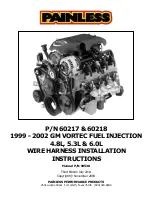
Section
01 V-810
ENGINE
Subsection
05
(CYLINDER AND HEAD)
CYLINDERS AND PISTONS
30
Engine oil
&
Engine oil
&
vmr2006-043
GENERAL
NOTE: Components which are identical for both
cylinders/cylinder heads are identified in the two
exploded views by the same number. Com
ponents which are different or which are, for
instance, present of one of the cylinders/cylinder
heads but not on the other, have different num
bers. The information given below always relates
as a general rule.
Special reference is made in the text to work in
structions which are not the same for front cylin
der no.
1,
and rear cylinder no.
2.
NOTE:
When diagnosing an engine problem, al
ways perform a cylinder leak test. This will help
pin-point a problem. Refer to the instructions in
cluded with your leak tester and
LEAK TEST
sec
tion for procedures.
Always place the vehicle on level surface.
NOTE:
For a better understanding, the many illus
trations are taken with engine out of vehicle.
To
perform the following instructions, it is not neces
sary to remove engine from vehicle.
Always disconnect BLACK {-} cable from the
..
bat
tery, then RED(+} cable before working on the en
gine.
Even if the removal of many parts is not neces
sary to reach another part, it is recommended to
remove these parts in order to check them.
During assembly/installation, use the torque val
ues and service products as in the exploded
views.
Clean threads before applying a threadlocker. Re
fer to
SELF-LOCKING FASTENERS
and
LOCTITE
APPLICATION
at the beginning of this manual for
complete procedure.
&
WARNING
Torque wrench tightening
specifications
must strictly be adhered to.
Locking devices (e.g.: locking tabs, elastic
stop nuts, self-locking fasteners, cotter p
i
n,
etc.) must be installed or replaced with new
ones where specified. If the efficiency
of
a
locking device is impaired, it must be re
newed.
vmr2006-04J
Section
01 V-810
ENGINE
Subsection
05
(CYLINDER AND HEAD)
When disassembling parts that are duplicated in
the engine, (e.g.: valves), it is a strongly recom
mended to note their position (PTO/MAG side,
front/rear cylinder) and to keep them as a "group".
If you find a defective component, it would be
much easier to find the cause of the failure among
its group of parts (e.g.: you found a worn valve
guide. A bent spring could be the cause and it will
be easy to know which one among the springs is
the cause to replace it if you grouped them at dis
assembly}. Also, since used parts have matched
together during the engine operation, they will
keep their matched fit when you reassemble them
together within their "group".
PROCEDURES
SPARK PLUG
Removal
Unplug and remove spark plug cable.
Clean spark plug area before disassembly.
Unscrew spark plug.
1. Spark plug cable
2. Spark plug
Inspection
Check spark plug condition and gap (refer to ap
propriate
VEHICLE SHOP MANUAL).
Installation
For installation, reverse the removal procedure.
Pay attention to the following details.
Screw spark plug. Reinstall the spark plug cable.
31
















































